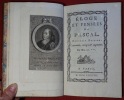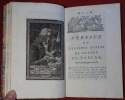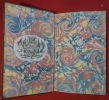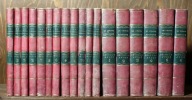9 books for « condorcet marie jean a... »Edit
-
Century
18th (5)
19th (2)
20th (1)
-
Topics
Condorcet (9)
Early printed books (1)
First edition (1)
Hatter (1)
Limited editions (1)
Memories (1)
-
Countries
Brazil (1)
Denmark (3)
France (2)
Germany (1)
Switzerland (2)
-
Syndicate
ILAB (5)
SLAM (1)
"CONDORCET, (MARIE JEAN ANTOINE NICOLAS CARITAT MARQUIS de).
Reference : 61971
(1797)
Udkast til et Historisk Skilderie af den menneskelige Aands Fremskridt. I Haandskrivt efterladt. Oversat af K.H. seidelin. - [CAN MAN BECOME PERFECT?]
København, Tikiøbs Forlag, 1797. 8vo. Bound in a contemporary half calf binding with gilt spine and gilt title label. Minor cracks to spine. Insignificant wear to capitals. Edges of boards worn. Corners bumped. Bibliographical notes to front free endpaper. Small ownership stamp to verso of title page. Evenly browned. XII,(2),368,(1: errata) pp.
The extremely rare first Danish edition of Condorcet's main work ""Esquisse d'un tableau historique des progrès de l'esprit humain.1795"", ""the most fully developed exposition of the progress of man"" (Printing and the Mind of Man, p. 149) and a main work of the Enlightenment as well as of historical thought in general. The author was the creator of what came to found the basis for the modern French system. The great French philosopher, political thinker and mathematician, M.J.A. Condorcet (1743 - 1794), played a seminal role in 18th century France. He was friends with the likes of d'Alembert, Voltaire, Turgot etc., and he greatly contributed to the social and political debates of politically turbulent France. As one of the few, he advocated a liberal economy, equality in public education as well as in gender and race etc. He preached constitutionalism, and his thoughts that are still influential today embody those of the Enlightenment and rationalism.""A belief in the ultimate perfectibility of man lies at the root of all progressive thinking about the human condition. The ""philosophes"" and Godwin had familiarized the reading public with this notion" it was left to Condorcet to give it its finest and most durable expression. It was the gospel of nineteenth century that mankind is destined for indefinite future progress. Condorcet, looking back and then forward, saw proof of this in the growing equality between classes and nations, the intellectual, physical and moral improvement of man" and he prophesied that popular education on correct principles would strengthen and assure this progress."" (PMM 246).During the French Revolution Condorcet came to play a dominating role, advocating a rationalist reconstruction of society, and he championed many liberal causes. In 1791 he became secretary of the Legislation Assembly, and the institution adopted his scheme for comprehensive state education, which later became the basis of the modern French system. In the struggle between the two political parties, the Girondists and the Montagnards, Condorcet occupied an independent role, but when he opposed the death penalty under the trial of King Louis XVI (still supporting the actual trial), and the radical Montagnards gained more power, Condorcet was branded a traitor, and in October 1793 a warrant was issued for his arrest. He now went into hiding for several months (almost a year), and it is during these months that he writes the work that was to become his most important, the main work ""Esquisse..."" (""Sketch for a Historical Picture of the Progress of the Human Mind""), which was published posthumously, the year after his death. In 1794 Condorcet was arrested, and two days later he was found dead in his cell, -it is unknown whether he committed suicide or was murdered because of fear of fierce reactions that would definitely have occurred had the beloved man been officially sentenced to the death penalty.""In the Esquisse"", published after his death, Condorcet traces the history of man through epochs, the first three covering his progress from savagery to pastoral community and thence to the agricultural state. The next five span the growth of civilizations and knowledge down to Descartes, and the ninth describes the revolution of Condorcet's own lifetime, from Newton to Rousseau. The prophetic view of the tenth epoch shows Condorcet at his most original. He forecasts the destruction of inequality between nation and classes, and the improvement, intellectual, moral and physical, of human nature..., it exercised considerable influence on Comte. But it is as the most fully developed exposition of the progress of man that Condorcet's work is now remembered, and it is this which has given it its lasting appeal."" (PMM 246).
"CONDORCET, (MARIE JEAN ANTOINE NICOLAS CARITAT MARQUIS de).
Reference : 42119
(1795)
Esquisse d'un tableau historique des progrès de l'esprit humain. - [PMM 246 - CAN MAN BECOME PERFECT?]
Paris, Agasse, l'an III de la République, une et indivisible (1795). 8vo. Bound in a very nice newer pastiche-binding in full mottled calf. Five raised bands and gilt title-label to spine. A very nice, clean, fresh, and attractive copy. VIII, 389 pp.
The rare first edition of Condorcet's main work, ""the most fully developed exposition of the progress of man"" (Printing and the Mind of Man, p. 149) and a main work of the Enlightenment as well as of historical thought in general. The author was the creator of what came to found the basis for the modern French system. The great French philosopher, political thinker and mathematician, M.J.A. Condorcet (1743 - 1794), played a seminal role in 18th century France. He was friends with the likes of d'Alembert, Voltaire, Turgot etc., and he greatly contributed to the social and political debates of politically turbulent France. As one of the few, he advocated a liberal economy, equality in public education as well as in gender and race etc. He preached constitutionalism, and his thoughts that are still influential today embody those of the Enlightenment and rationalism.""A belief in the ultimate perfectibility of man lies at the root of all progressive thinking about the human condition. The ""philosophes"" and Godwin had familiarized the reading public with this notion" it was left to Condorcet to give it its finest and most durable expression. It was the gospel of nineteenth century that mankind is destined for indefinite future progress. Condorcet, looking back and then forward, saw proof of this in the growing equality between classes and nations, the intellectual, physical and moral improvement of man" and he prophesied that popular education on correct principles would strengthen and assure this progress."" (PMM 246).During the French Revolution Condorcet came to play a dominating role, advocating a rationalist reconstruction of society, and he championed many liberal causes. In 1791 he became secretary of the Legislation Assembly, and the institution adopted his scheme for comprehensive state education, which later became the basis of the modern French system. In the struggle between the two political parties, the Girondists and the Montagnards, Condorcet occupied an independent role, but when he opposed the death penalty under the trial of King Louis XVI (still supporting the actual trial), and the radical Montagnards gained more power, Condorcet was branded a traitor, and in October 1793 a warrant was issued for his arrest. He now went into hiding for several months (almost a year), and it is during these months that he writes the work that was to become his most important, the main work ""Esquisse..."" (""Sketch for a Historical Picture of the Progress of the Human Mind""), which was published posthumously, the year after his death. In 1794 Condorcet was arrested, and two days later he was found dead in his cell, -it is unknown whether he committed suicide or was murdered because of fear of fierce reactions that would definitely have occurred had the beloved man been officially sentenced to the death penalty.""In the Esquisse"", published after his death, Condorcet traces the history of man through epochs, the first three covering his progress from savagery to pastoral community and thence to the agricultural state. The next five span the growth of civilizations and knowledge down to Descartes, and the ninth describes the revolution of Condorcet's own lifetime, from Newton to Rousseau. The prophetic view of the tenth epoch shows Condorcet at his most original. He forecasts the destruction of inequality between nation and classes, and the improvement, intellectual, moral and physical, of human nature..., it exercised considerable influence on Comte. But it is as the most fully developed exposition of the progress of man that Condorcet's work is now remembered, and it is this which has given it its lasting appeal."" (PMM 246).
Condorcet (Marie Jean Antoine Nicolas Caritat, Marquis de):
Reference : 59131BB
(1795)
Esquisse d'un tableau historique des progrès de l'esprit humain. Ouvrage posthume de Condorcet.
Paris, Chez Agasse. L'an III. (i.e. 1795). 8°. VIII S., 389 S. Halblederband der Zeit mit rotem goldgeprägtem Rückenschild und wenig Rückenvergoldung.
En Français dans le texte 196. - Erste Ausgabe von Condorcets philosophischem Hauptwerk, die umfassendste und beste Darstellung des menschlichen Fortschritts, posthum erschienen. Es ist die Zusammenfassung der Philosophie der Aufklärung mit ihrem Glauben an die Vernunft als Voraussetzung des Fortschrittes. Ein Text der auf der historischen Darstellung aufbauend in seiner Aussage gerade wieder von höchster Aktualität ist. Condorcet sprach sich in seinen Schriften für die Emanzipation aller Geschlechter, Rassen und Religionen aus. - Exemplar in einem schlichten Halblederband der Zeit mit kleiner Fehlstelle am oberen Kapital. Deckel fleckig, Stehkanten beschabt. Der fliegende Vorsatz gelockert. Vereinzelt fleckig. - En Français dans le texte 196. - Première édition. Première édition de l'œuvre philosophique majeure de Condorcet, la description la plus complète et la meilleure du progrès humain, publiée à titre posthume, elle résume la philosophie des Lumières avec sa croyance en la raison comme condition préalable au progrès. Un texte qui, s'appuyant sur la description historique, est à nouveau d'une actualité brûlante. Dans ses écrits, Condorcet s'est prononcé en faveur de l'émancipation de tous les sexes, races et religions. - Exemplaire dans une reliure sobre en demi-cuir d'époque avec une petite imperfection sur la tranche supérieure. Couverture tachée, bords abîmés. Page de garde détachée. Quelques taches éparses.
Esquisse d'un tableau historique des progrès de l'esprit humain suivi de "Fragment sur l'Atlantide"
Flammarion 1988 poche. 1988. broché. 352 pages. Bon Etat intérieur propre
Voltaires Levnet, tilligemed hans Domme over Religion og Bibel. Oversat ved O. Horrebow.
Kiøbenhavn: A. Soldin, 1802. 8vo. Indbundet i et samtidigt hldrbd. med rygforgyldning. Titeletiket i skind med forgyldt titel. Kantslid. Øvre kapitæl slidt. Hjørner stødte. Et brændemærke på forpermermen har afgivet en brunplet på de første 6 blade. Enkelte brunpletter, ellers ren og pæn. Trykt på godt papir. Ex libris Nicolai Bøgh.
Titeloplag, idet indholdet er identisk med førstetrykket fra 1798.
VOLTAIRE (François Marie AROUET de), CONDORCET (Marie Jean Antoine Caritat de)
Reference : 14811
(1778)
Éloge et pensées de Pascal. Nouvelle Edition, commentée, corrigée et augmentée par Mr. de ***
1778 Paris (Genève), 1778, sans nom d'éditeur (Grasset), in 8 de XII-316 pp., titre encadré portrait de Pascal gravé par Demeuse en frontispice et portrait de Voltaire gravé par Brichet placé face à la préface, page 163 numérotée par erreur 139, jolies vignettes gravées sur bois, culs de lampes etc., rel. d'ép. plein veau fauve marbré, dos lisse orné de fers dorés, pièce de titre de maroquin rouge, tranches jaspées de couleurs, bel ex.
Édition rare. Dès 1776, Condorcet avait fait paraître les "Pensées de Pascal. Nouvelle édition", avec des notes de Voltaire extraites de la 25e lettre des "Lettres philosophiques". Il s'agit ici de la réédition de cet ouvrage que Voltaire fit imprimer à Genève par Grasset ("voir" sa lettre à Wagnière du 14 mai 1778, Besterman, n° 20027) Voltaire l'augmenta d'un "Avertissement du nouvel éditeur" et de nouvelles notes, au bas des pages signées : "Note du présent éditeur", ou "second éditeur", elles sont au nombre de cent vingt-huit. Les notes de Condorcet sont signées : "Premier éditeur, auteur de l'Éloge". Voltaire indique, dans son "Avertissement", que l'attribution à Fontenelle du texte joint par Condorcet à son édition : "Réflexions sur l'argument de M. Pascal et de M. Locke, concernant la possibilité d'une autre vie à venir", lui paraît erronée. Ce livre est probablement le dernier qu'ait fait imprimer Voltaire. L'"Éloge" et les "Pensées" furent réimprimés en 1780 pour former le t. XVI de "L'Évangile du jour". (Notes de la Bibliothèque Nationale). Cet ouvrage a été condamné par décret de la Cour de Rome du 18 septembre 1789. (Bengesco, 1910). Bel ex-libris armorié gravé du XVIIIe siècle.
Mémoires de Condorcet sur la Révolution Française. Extraits de Sa Correspondance et de Celles de Ses Amis.
Paris,Ponthieu en 1824.2 vols.in-8 en demi-reliure de l'époque.362 et 390 pages avec les Tables des Matières.Mémoires apocryphes tirés de la correspondance de Condorcet avec Suard,Morellet,Rousseau,D'Alembert,Diderot etc..Bon état avec qques rousseurs.
CONDORCET [Marie Jean Antoine Nicolas de Caritat] Marquis de; PEYSONEL [Claude-Charles] de; LE CHAPELIER [Isaac-René-Guy]:
Reference : 9307
(1790)
Bibliothèque de l'homme public; ou analyse raisonnée des principaux ouvrages françois et étrangers, Sur la Politique en général, la Législation, les Finances, la Police, l'Agriculture, & le Commerce en particulier, & sur le Droit naturel & public [avec] Bibliothèque de l'homme public [...] Seconde année.
A Paris, chez Buisson, 1790-1791. 24 tomes en 18 volumes petit in-8, demi-vélin teinté rouge à coins, dos lisses ornés de roulettes et filets dorés, étiquettes de titre et tomaison vertes. Reliures un peu frottées, dos légèrement passés, minimes manques à quelques étiquettes, quelques taches au papier des plats, très rares rousseurs, quelques auréoles. A noter que les étiquettes de titre orthographient "public" avec la terminaison -que. Les 12 numéros de la première années sont reliés indépendamment, les 12 de la seconde sont reliés à raison de 2 numéros par volume, sous la même reliure toutefois.
Cette revue "avait pour but de mettre autant que possible la science du gouvernement et de l'administration à la portée de tout le monde." Hatin, Bibliographie historique et critique de la presse française, p. 162. Figurent ici de nombreux textes et articles de Condorcet, dont les fameux Cinq Mémoires sur l'instruction publique, mais également des études sur les physiocrates, Adam Smith, Locke, Hume, Rousseau, Voltaire, and so on! Le Siècle des Lumières, amputé toutefois ici des dernières livraisons (soit 4 tomes, la parution continuera l'année suivante). Malgré tout, terriblement rare. INED, 1166.
Marie-Jean-Antoine Nicolas de Caritat, marquis de Condorcet ; Arthur Condorcet O'Connor ; François Arago
Reference : 0496
(1847)
Œuvres de Condorcet publiées par A. Condorcet O'Connor, lieutenant-général, et M. F. Arago, secrétaire perpétuel de l'Académie des Sciences
Paris, Firmin-Didot, 1847-49. Édition originale des œuvres complètes du philosophe par son gendre et le savant François Arago. Quasi complet, seul le volume X manque. Onze forts volumes (sur les 12) de 154 x 231 mm reliés demi-chagrin grainé tabac, dos à 5 nerfs, mention "ŒUVRES DE CONDORCET" et tomaison en caractères d'imprimerie dorés. Gardes colorées, portrait de Condorcet en frontispice sous papier de soie. Plus de 5500 pages en tout : tome I, Biographie de Condorcet par Arago et œuvres diverses, CLXXXVI et 652 pp. ; tome II, Éloges I, VIII et 672 pp. ; tome III, Éloges II, 664 pp. ; tome IV, Mélanges de littérature et de philosophie I, 644 pp. ; tome V, Mélanges de littérature et de philosophie II, 575 pp. ; tome VI, Mélanges de littérature et de philosophie III, 662 pp. ; tome VII, Économie politique et politique I, 575 pp. ; tome VIII, Économie politique et politique II, 662 pp. ; tome IX, Économie politique et politique III, 547 pp. ; tome X manquant ; tome XI, Politique I, 676 p. ; tome XII, Politique II, 690 pp. Marie-Jean-Antoine Nicolas de Caritat, marquis de Condorcet (1743-1794), fut l'une des grandes figures intellectuelles du mouvement des Lumières. "Célèbre pour ses travaux pionniers en statistique et en probabilités, pour son analyse des modes de scrutin, le vote Condorcet, « théorème du jury » et le paradoxe de Condorcet, ainsi que pour ses écrits philosophiques et son action politique, notamment contre l'esclavage et pour l'égalité des sexes, tant avant la Révolution que sous celle-ci. Siégeant parmi les girondins, il propose la refondation du système éducatif ainsi que celle du droit pénal." (Wikipédia) Grand ami de d'Alembert, puis de Voltaire, il finit par se mettre la Convention révolutionnaire à dos et mourut dans des circonstances mal connues sous la Terreur alors qu'il était au cachot. Quelques rousseurs à travers les volumes, très petits trous de ver à certains sans perte au texte, frontispice bien présent, petits manques au cuir en coiffe et queue de certains volumes, cuir du dos du vol. XII en bonne partie manquant. Bon état général. Complet hors le volume X manquant.
Considérée comme la "meilleure édition collective des œuvres de Condorcet", cette publication a été revue sur les manuscrits du philosophie. Renferme plusieurs écrits inédits de Condorcet ainsi que nombre de lettres de Voltaire (Bengesco, III, 2058) et de Turgot. Rarissime et quasi introuvable. Cité par Brunet (II, 216) et par l'INED (1173). IMPORTANT : les frais de port sont inclus dans le prix !
 Write to the booksellers
Write to the booksellers


![Esquisse d'un tableau historique des progrès de l'esprit humain. - [PMM 246 - CAN MAN BECOME PERFECT?]. "CONDORCET, (MARIE JEAN ANTOINE NICOLAS ...](https://static.livre-rare-book.com/pictures/LLX/42119_1_thumb.jpg)
![Esquisse d'un tableau historique des progrès de l'esprit humain. - [PMM 246 - CAN MAN BECOME PERFECT?]. "CONDORCET, (MARIE JEAN ANTOINE NICOLAS ...](https://static.livre-rare-book.com/pictures/LLX/42119_2_thumb.jpg)










